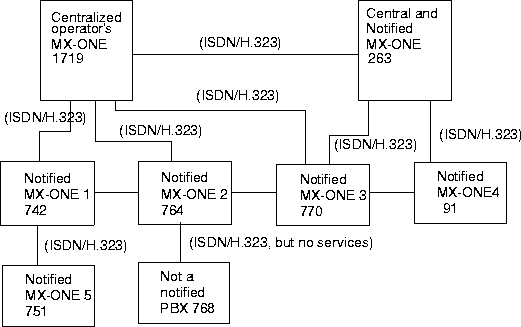Day/Night Status Notification between Exchanges
This function is only valid when the central answer position is a PBX operator. The function will not apply in the case of a CCOP. The most simple configuration using status notification would be according to the figure below, where one COP's MX-ONE, with own exchange number 719, notifies one sub-exchange, 742, of the day/night status.

A private exchange network can have one or several centralized PBX operators. A centralized PBX operator's exchange can notify a maximum of 64 different other exchanges in the network of the status for day/night service. This is done, with a delay of about 15 seconds, when the status for day/night service is changed and also repeatedly, when the status is day, with a time interval of approximately 5 minutes.
A notified exchange can be notified by three different central exchanges.

In the figure above, there are two exchanges which are central operator exchanges, and five sub-exchanges, plus one exchange (768) which is not part of the ISDN or H.323 network regarding services. The numbers 742, 63 etc. indicate the own exchange numbers. Any of the exchanges may have incoming public external lines.
The central MX-ONE with the own exchange number 719 notifies five other exchanges of its day/night status, namely the MX-ONE systems (PBXes) with numbers 742, 751, 764, 770 and 63. Exchange 63 notifies 770, 91 and 719, that is, three others. So a central operator's exchange can at the same time be a notified exchange. Exchange 770 is controlled by both 719 and 63. Exchange 768 is not controlled by any central operators.
Note: For the VPN scenarios, the exchange number of a notifying node must be included in the DID number series, or else the public network may reject the notification call.
The day/night status of an exchange can be controlled by different criteria, as described in the Day/night status control clause, but it is always the PBX operator presence or absence, not the exchange's day/night status, that controls what is sent in the notification messages between MX-ONE systems.
Sub-Exchange Day/Night Status Control
The status of a notified sub-exchange is controlled by its central exchange(s) in the way described below.
There is an AS parameter which is changeable by command ASPAC, PARNUM=64, which must be used in the notified exchange.
If PARNUM=64 is set equal to 0 in the notified exchange, this exchange's day/night status is ONLY controlled by local criteria, that is, the central operator's status does not matter. See the table below, where COP's MX-ONE means Central operator's exchange.
DAY/NIGHT-STATUS IN THE NOTIFIED PBX (PARNUM=64 set equal to 0)
| COP's MX-ONE state | TCD check = Notified MX-ONE state | Rerouting mode (external lines) |
|---|---|---|
NIG |
NIG |
NIG |
NIG |
DAY |
DAY |
DAY |
DAY |
DAY |
DAY |
NIG |
NIG |
If PARNUM=64 is set to 1 in the notified exchange, this exchange's status is controlled by the local and the central operator's status in the way described in the table below.
Note: Exchange status means its mode of operation, that is, if the call discrimination check is the one used at day-time or the one used at night-time. PARNUM=64 controls the external/network Rerouting function, but not the Call Discrimination function, like this:
| COP's MX-ONE state | TCD check = Notified MX-ONE state | Rerouting mode (external lines) | Comment |
|---|---|---|---|
NIG |
NIG |
NIG |
|
NIG |
DAY |
NIG |
|
DAY |
DAY |
DAY |
|
DAY |
NIG* |
NIG* |
* Only possible if notification does not work, or during the delay before notification. |
With PARNUM=64 set equal to 1, in a notified exchange, the OPIs will show day switched as long as there is at least one day switched central exchange, even if all local PBX operators in the notified exchange are absent, and the PBX operator absence/presence criteria is used.
Note: The notified exchange cannot be night switched, while there is at least one day switched central operator (except if notification has failed due to an error case, or in the time interval before Notification has been executed).
Prerequisites
Homogeneous ISDN/H.323 networks must be used, and network facilities must be available.
The exchanges included in the private network, must have their own exchange numbers initiated even if closed (coordinated) numbering plan is used. These exchange numbers can be specific numbers used only for the day/night status notification. See the operational directions for NUMBER ANALYSIS, NA, and see the operational directions for NUMBERING.